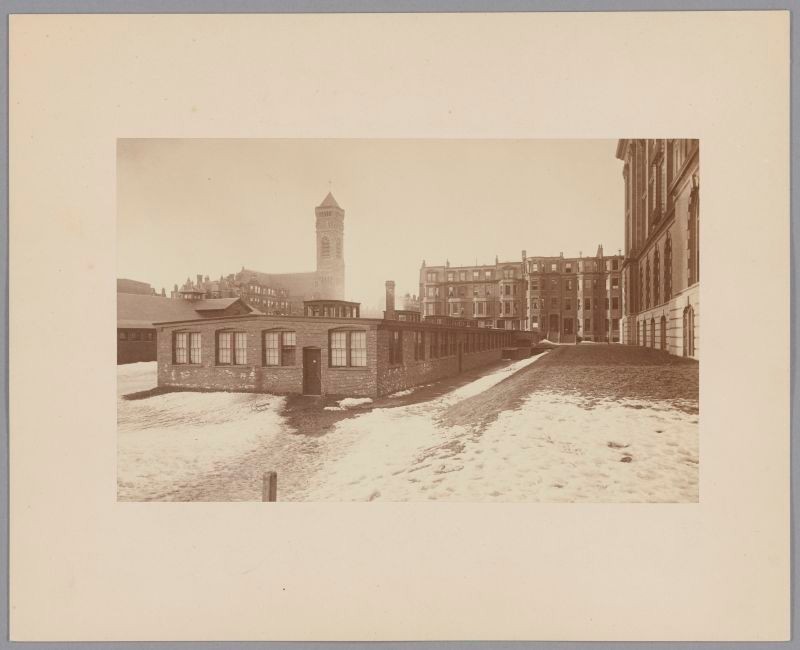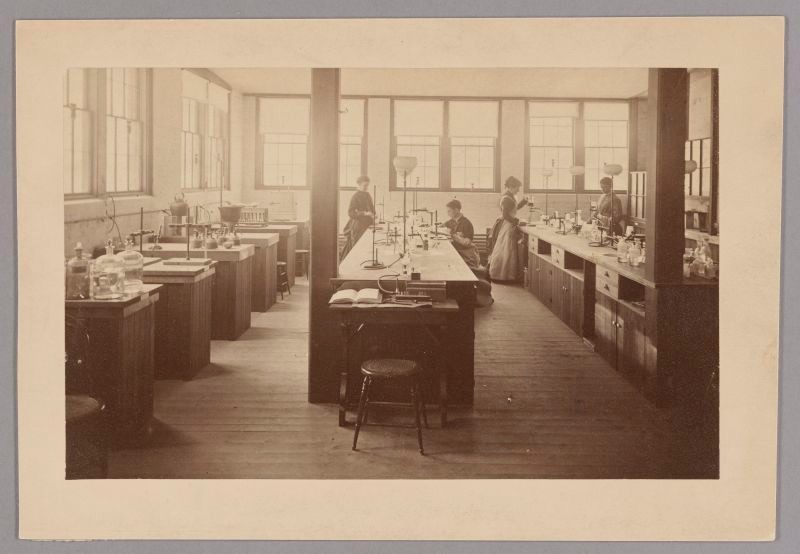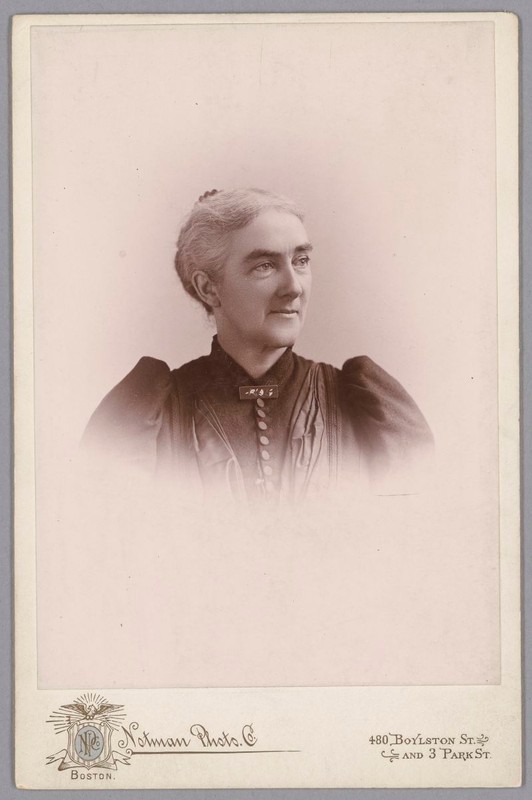Site of the MIT Woman's Laboratory (1876-1883) - STEM Education for Women
Introduction
Text-to-speech Audio
Ellen Swallow graduated from the Massachusetts Institute of Technology (MIT) in 1873 with a Bachelor of Science in just two years, yet MIT’s doors remained closed to women. The Institute believed her to be an exception, an outlier. Ellen proved to be an exception - an exceptional advocate for women’s education. In 1876 she established the Woman’s Laboratory to create better opportunities for the scientific education of women. Over the next six years, Ellen instructed over 100 women - most were educators who would go on to prepare hundreds of young women to pursue STEM fields.
The building that originally housed the Woman's Laboratory was demolished in 1883 to make way for the Walker Building completed in 1884. Standing at the corner of Boylston Street and Clarendon Street, the Church steeple visible to the left is the same church steeple seen in the photograph of the exterior of the Woman's Laboratory (MIT Annex).
Images
The Woman's Laboratory (1876-1883), Building 04, The Annex, Boston Campus, exterior

Photograph from Women at MIT -- Academics -- Laboratories -- Women's Laboratory file

Ellen Henrietta (Swallow) Richards, circa 1880

Backstory and Context
Text-to-speech Audio
The decision to admit Ellen to MIT was not unanimous. But even those opposed, like Professors William Ripley Nichols and John Ordway, soon recognized Ellen’s exceptional analytical skills. Both men would recruit Ellen as an assistant, then grant her independence as a peer. By 1873 she was nationally recognized as an expert in Water Analysis and Industrial Chemistry.
After completing her degrees, Ellen worked at MIT without pay and earned her room and board through private commissions and lecture fees. Her June 1875 marriage to Professor Robert Richards gave her the financial security to expand her portfolio. That November, Ellen presented the Woman’s Educational Association (WEA) with a proposal to establish a laboratory program in advanced chemistry for women at MIT. MIT agreed to provide the space if the WEA funded the equipment, books, and supplies. “[Mrs. Richards] gave an interesting account of the work possible for women and the present opportunities and demand for instruction here in Boston, both of which have grown chiefly from the [class taught with Miss Bessie Capen], sustained at the High School for Girls three years ago by this association.”13 The WEA approved Ellen’s request and began fundraising that winter.
Ellen’s advocacy was gaining momentum. On May 10, 1876, MIT voted to approve the use of the Rogers Annex for the Woman’s lab and accepted the WEA’s funding condition "that hereafter special students in Chemistry shall be admitted without regard to sex."14 With space and funding secured, Ellen, Robert, and Bessie left for Europe to buy equipment for the Woman’s Laboratory. Although MIT opened the lab in November 1876 under the direction of Professor John Ordway, Ellen was the actual supervisor and used personal funds to provide scholarships to young women and cover expenses, such as additional instruments and housekeeping. Even Professor Ordway volunteered his time and donated funds to support the lab.
Over half of the first 14 women to register as Special Students in Chemistry were pioneers in education and science. Bessie Capen (Class of 1878) became one of the first Professors of Chemistry at Wellesley College, then Smith College, and later co-founded a college preparatory school for girls. Lucia Peabody (1878) was one of the first women elected to the Boston School Committee in 1873 and served through 1883, often winning decisive victories over male candidates. Rhoda E. Cole (1879), Mary L. B. Capen Reynolds (1879), and Laura Bradstreet White (1879) taught at the Boston Girls’ High School. In a few years, Laura would become the Head Science teacher. Margaret Swan Cheney (Class of 1882) and Alice W. Palmer (1890) co-authored papers published in scientific journals with Ellen.
By the end of the first year, WEA records indicate up to 25 women had participated in the program. In her first annual report, Ellen states, “It is always pleasant to us to have our prophecies fulfilled and especially pleasant when some doubt has been expressed as to the probability of fulfillment. I hope to be pardoned therefore if I seem to boast of the fulfillment of my own predictions […] First in importance we may place that of aid rendered to the teachers […] All their instruction has had for its end the broadening of their ideas of science and fitting them thus to impress on their pupils the depths of the channel and not merely its surface breadth as is so apt to be the result of popular scientific teaching.”3
MIT officially acknowledged Ellen as an Instructor in 1882, yet waited until 1884 to offer her a salary of $600 per year, raising it a month later to $1000 per year. According to the 1884 Boston Directory, Girls’ High School Chemistry Teachers earned $1380 per year.10,16
In 1883 the Woman’s Laboratory was torn down to make room for the Walker Building. Ellen petitioned Alumnae and the WEA to help preserve a place for women at MIT. “We women have raised ten thousand dollars and given to the Institute to make suitable provision for women students in all departments. The new building, equal in size nearly to the old, is to be ready in October [1884].”4 The 1883-84 MIT Course Catalog acknowledges the end of the Woman’s Laboratory continuing: “Through the changes made during the past year, these and better opportunities for the higher education of women in scientific pursuits are now offered in the Kidder Laboratories of Chemistry, and in the Physical, Biological, and other Laboratories; and the Margaret Cheney Memorial Reading Room has been opened for the use of young women who may be students in the School. Women who are properly qualified are admitted to any of the courses of the School.”5 MIT’s door had finally opened.
Ellen believed in the power of education for the individual and society: “A nation cannot rise rapidly when one half is a drag. Instead of shutting the door of technical and professional work to women, they who love mankind should hold it wide open to allow the utilization of the added energy which may, perchance, move the car of progress up and over the Hill Difficulty.”8 Progress for women would be slow, but Ellen’s car was in motion.
Sources
- Bever, Marilynn. “The Women of M.I.T., 1871-1941 : Who They Were, What They Achieved.” MIT Libraries | DSpace@MIT, Massachusetts Institute of Technology, 1976, http://hdl.handle.net/1721.1/33804.
- Collection on the Massachusetts Institute of Technology Woman's Laboratory, AC 298. Massachusetts Institute of Technology, Department of Distinctive Collections, Cambridge, Massachusetts. https://archivesspace.mit.edu/repositories/2/resources/254. Accessed 1 Nov. 2022.
- “Ellen Swallow Richards: Women’s Laboratory: Institute Archives & Special Collections: MIT.” Archive-It Wayback Machine, Aug. 1999, https://wayback.archive-it.org/7963/20190702115916/https://libraries.mit.edu/archives/exhibits/esr/esr-womenslab.html#report. Accessed 14 Mar. 2022 [This page was captured on 11:59:16 Jul 02, 2019, and is part of the MIT Institutional Websites collection.]
- Hunt, Caroline L 1865-1927. The Life of Ellen H. Richards. Anniversary Edition, American Home Economics Association, 1958, https://hdl.handle.net/2027/uc1.b3888672. Accessed 11 Mar. 2022.
- Massachusetts Institute of Technology. Institute Archives and Special Collections. Collection: Course Catalogues of the Massachusetts Institute of Technology: 1876-1884. https://dome.mit.edu/handle/1721.3/81660. Accessed 25 Oct 2022.
- Register of Former Students, Bulletin of the Massachusetts Institute of Technology, Massachusetts Institute of Technology, 1912. https://books.google.com/books?id=5mc9AAAAYAAJ Accessed 15 October 2022.
- Reynolds, Mary L. B. “Miss Bessie T. Capen; educator.” Stoughton Sentinel 3-4 August 1933: 2. Microform. History of Women (1976): Reel 968, M5.
- Richards, Ellen H. “Desirable Tendencies In Professional And Technical Education For Women” AAUW journal. v.3:16-18 (1907-08). https://hdl.handle.net/2027/uc1.b2864680?urlappend=%3Bseq=185%3Bownerid=9007199274020638-189. Accessed 23 Oct. 2022.
- Swallow, Pamela C. The Remarkable Life and Career of Ellen Swallow Richards. John Wiley & Sons, 2014.
- “The Boston Directory. [1884].” Internet Archive, Published by George Adams, 1884. https://archive.org/details/bd-1884/page/1405/mode/1up. Accessed 1 Nov. 2022.
- “The Vote for School Committee.” The Boston Daily Globe, 10 Dec. 1873, p. 4.
- “Vote for School Committee.” The Boston Post, 15 Dec. 1880, p. 4.
- Woman's Education Association (Boston, Mass.), Records Massachusetts Historical Society. General meeting records, 1871–1929: Box 2, Folder 2, 1874-1876, Images 60-62. https://www.masshist.org/collection-guides/digitized/fa0393/b02-f02#61. Accessed 1 Nov. 2022.
- Woman's Education Association (Boston, Mass.), Records Massachusetts Historical Society. Founding and historical documents, 1872–1921: Box 1, Folder 9, Chemical laboratory for women at MIT, 1876–1883, Image 4. https://www.masshist.org/collection-guides/digitized/fa0393/b01-f09#4. Accessed 1 Nov. 2022.
- Woods, Lucy. “A History of the Girls’ High School of Boston, 1852-1902 : Woods, Lucy Rae, 1847? - 1904.” Internet Archive, [Boston] : Printed at the Riverside Press, 1904, https://archive.org/details/historyofgirlshi00wood/page/n9/mode/2up. Accessed 14 Mar. 2022.
- “Ellen Swallow Richards & MIT: Institute Archives & Special Collections: MIT.” Archive-It Wayback Machine, https://wayback.archive-it.org/7963/20190702115845/https://libraries.mit.edu/archives/exhibits/esr/esr-mit.html. Accessed 12 July 2023. [This page was captured on 11:58:45 Jul 02, 2019, and is part of the MIT Institutional Websites collection]
1. Woman's Lab, Building. Courtesy of the MIT Museum. https://mitmuseum.mit.edu/collections/object/GCP-00038507. Accessed 4 Jan. 2023.
2. Women working in the Lab. Courtesy of the MIT Museum. https://mitmuseum.mit.edu/collections/object/GCP-00059062. Accessed 16 Jan. 2023.
3. Ellen Swallow Richards. Courtesy of the MIT Museum. https://mitmuseum.mit.edu/collections/object/GCP-00024186. Accessed 16 Jan. 2023.
